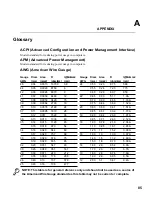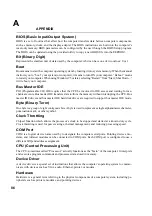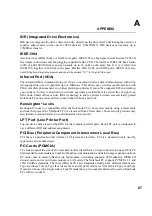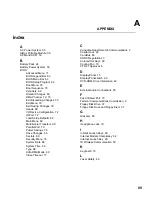
88
APPENDIX
A
POST (Power On Self Test)
When you turn on the computer, it will first run through the POST, a series of software-controlled
diagnostic tests. The POST checks system memory, the motherboard circuitry, the display, the key-
board, the diskette drive, and other I/O devices.
PS/2 Port
PS/2 ports are based on IBM Micro Channel Architecture. This type of architecture transfers data through
a 16-bit or 32-bit bus. A PS/2 mouse and/or keyboard may be used on ATX motherboards.
RAM (Random Access Memory)
There are several different types of RAM such as DRAM (Dynamic RAM), EDO DRAM (Extended
Data Output DRAM), SDRAM (Synchronous DRAM).
ROM (Read Only Memory)
ROM is nonvolatile memory used to store permanent programs (called firmware) used in certain com-
puter components. Flash ROM (or EEPROM) can be reprogrammed with new programs (or BIOS).
Suspend Mode
In Save-to-RAM (STR) and Save-to-Disk (STD), the CPU clock is stopped and most of the Notebook PC
devices are put in their lowest active state. The Notebook PC enters Suspend when the system remains
idle for a specified amount of time or manually using the function keys. The timeout setting of both Hard
Disk and Video can be set by the BIOS Setup. The Power LED blinks when the Notebook PC is in STR
mode. In STD mode, the Notebook PC will appear to be powered OFF.
System Disk
A system disk contains the core file of an operating system and is used to boot up the operating system.
Twisted-Pair Cable
The cable used to connect the Ethernet card to a host (generally a Hub or Switch) is called a straight-
through Twisted Pair Ethernet (TPE). The end connectors are called RJ-45 connectors, which are not
compatible with RJ-11 telephone connectors. If connecting two computers together without a hub in
between, a crossover twisted-pair is required.
UltraDMA/33
UltraDMA/33 is a new specification to improve IDE transfer rates. Unlike traditional PIO mode, which
only uses the rising edge of IDE command signal to transfer data, UltraDMA/33 uses both rising edge
and falling edge. Hence, the data transfer rate is double of the PIO mode 4 or DMA mode 2. (16.6MB/
s x2 = 33MB/s).
USB (Universal Serial Bus)
A new 4-pin serial peripheral bus that allows plug and play computer peripherals such as keyboard,
mouse, joystick, scanner, printer and modem/ISDN to be automatically configured when they are at-
tached physically without having to install drivers or reboot. With USB, the traditional complex cables
from back panel of your PC can be eliminated.
Summary of Contents for T9A
Page 11: ...10 About This User s Manual Notes For This Manual 1 Introducing the Notebook PC ...
Page 13: ...12 Top Side Bottom Side Left Side Right Side Rear Side Front Side 2 KNOWING THE PARTS ...
Page 81: ...80 APPENDIX Internal Modem Compliancy Glossary Owner Information ...
Page 84: ...84 APPENDIX A ...
Page 91: ...91 APPENDIX A ...





































